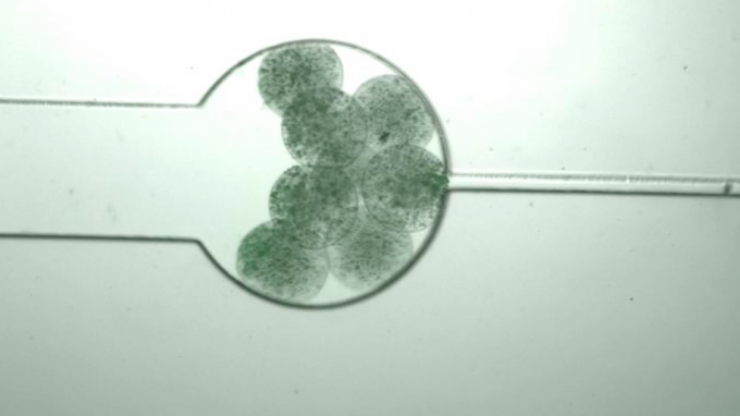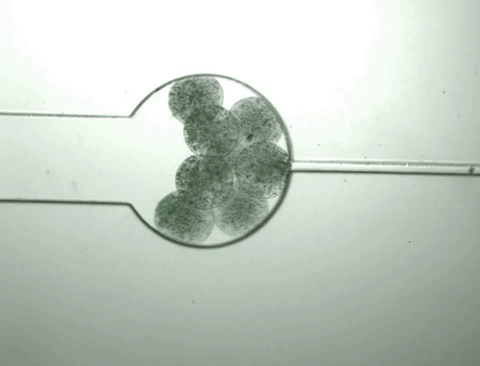创新背景
sIPN的概念已经有100多年的历史,已被用于汽车零部件、医疗设备、成型化合物和工程塑料。一般的想法是,一个或多个聚合物围绕另一个聚合物支架组装,以这种方式,他们成为连锁。即使这些聚合物没有化学结合,它们也不能被分开,形成一种比其各部分简单相加更具有性能的新材料。
传统的制造sIPN的方法通常包括生产被称为单体的组成部分,并在适当的化学条件下将它们混合在一起,以控制它们在聚合过程中组装成大型网络。
当它工作时,可以将不同的功能合并到自组装层中,用于生物医学或环境应用。但这个过程往往不太具有生物相容性。
创新过程
杜克大学的生物医学工程师已经证明了一种被称为半互穿聚合物网络的交织复合材料可以由活细胞产生。这种方法可以使这些多功能材料在生物医学应用中更具生物相容性,如延时给药系统。
蜂群机器人是活细胞,它们被设定在细胞壁内产生生物分子,一旦数量达到一定密度就会爆炸。在这种情况下,它们被编程生成一种叫做弹性样多肽(ELPs)的单体,融合到称为SpyTag和SpyCatcher的功能特征上。这两种分子结构形成了一个锁和钥匙系统,允许elp在混合时自组装成聚合物链。随着它们的生长,这些聚合物与含有细胞的聚合微胶囊纠缠在一起,形成sIPN。

“Swarmbots”是设计用于产生单体分子的活细胞,它们会生长,直到它们感觉到它们的种群密度达到一定水平,然后它们会爆裂开来,使单体能够混合并自我组装成复合聚合物
每个单体可以包含多个间谍标签或间谍捕捉器,也可以与蛋白质融合,产生读数或具有特定功能。这有点像用许多小手镯做一个链链栅栏,有足够的空间来放扣子和护身符。
研究人员首先对细胞进行编程,用荧光蛋白填充这种可搭配的特征,以证明该系统可以将它们锁定在适当的位置。在那次成功的演示之后,他们将注意力转向用他们的新发明设计一个有用的药物输送系统。
β-内酰胺类抗生素,如青霉素及其衍生物,是世界上最常用的抗生素之一。它们也经常被过度使用,会产生负面影响,比如破坏生活在人体肠道内的天然微生物群。

为了展示新细胞构建的sIPNs可能有用的一种方式,研究人员用β-内酰胺酶填充了可辅助的位置,它可以降解β -内酰胺类抗生素。通过将新功能化的sIPNs注射到小鼠体内,研究人员表明,该平台可以缓慢释放原本短暂的保护分子,以帮助小鼠的肠道微生物群抵御抗生素的负面副作用。
创新关键点
蜂群机器人是活细胞,它们被设定在细胞壁内产生生物分子,一旦数量达到一定密度就会爆炸。在这种情况下,它们被编程生成一种叫做弹性样多肽(ELPs)的单体,融合到称为SpyTag和SpyCatcher的功能特征上。这两种分子结构形成了一个锁和钥匙系统,允许elp在混合时自组装成聚合物链。随着它们的生长,这些聚合物与含有细胞的聚合微胶囊纠缠在一起,形成sIPN。
创新价值
研究人员表明,该平台可以缓慢释放原本短暂的保护分子,以帮助肠道微生物群抵御抗生素的负面副作用。
Using living cells to build "semi-interpenetrating polymer networks" makes drug delivery safer
Biomedical engineers at Duke University have shown that an interwoven composite called a semi-interpenetrating polymer network can be produced by living cells. This approach could make these multifunctional materials more biocompatible for biomedical applications, such as time-lapse drug delivery systems.
Swarm robots are living cells programmed to produce biomolecules within their cell walls that explode once their numbers reach a certain density. In this case, they are programmed to generate monomers called elastic-like peptides (ELPs) that fuse to functional features called Spytags and spycatchers. These two molecular structures form a lock and key system that allows ELP to self-assemble into polymer chains when mixed. As they grow, these polymers become entangled with polymerized microcapsules containing cells to form sIPN.
Each monomer can contain multiple spy tags or spy catchers, or it can fuse with proteins to produce readings or have specific functions. It's a bit like making a chain-link fence out of lots of little bracelets, with plenty of room for buttons and amulets.
The researchers first programmed the cells to fill the collocatable features with fluorescent proteins to demonstrate that the system could lock them in place. After that successful demonstration, they turned their attention to designing a useful drug delivery system with their new invention.
Beta-lactam antibiotics, such as penicillin and its derivatives, are among the most commonly used antibiotics in the world. They are also often overused and can have negative effects, such as disrupting the natural microbiome that lives in the human gut.
To show one way in which new-cell constructs of sIPNs might be useful, the researchers filled the adjunctable sites with β-lactamases, which degrade β-lactam antibiotics. By injecting the newly functionalized sIPNs into mice, the researchers showed that the platform can slowly release otherwise transient protective molecules to help the gut microbiota of mice resist the negative side effects of antibiotics.
智能推荐
基因工程创新 | 创新开发“基因递送系统”特异性地靶向脑细胞
2022-10-12加州理工学院研究人员开发了一种基因递送系统,可以特异性地靶向脑细胞,同时避开肝脏。
涉及学科涉及领域研究方向新材料 | 开发新型生物材料可加速身体自愈过程
2022-09-29研究团队为外科医生设计了一种绷带,植入骨折部位可加速自然愈合过程。
涉及学科涉及领域研究方向生物医学创新 | 创新利用“双轴法”增加OCT在生物组织中的视野深度
2022-09-28杜克大学的生物医学工程师展示了一种增加光学相干断层扫描(OCT)对皮肤下结构成像的深度的新方法——双轴法。
涉及学科涉及领域研究方向生物医学工程创新 | 将抗生素涂层创新应用于骨科植入物可降低感染机会
2022-09-28杜克大学的生物医学工程师等人发明了一种抗生素涂层,可以在手术前几分钟涂在骨科植入物上,从而消除植入物周围感染的机会。
涉及学科涉及领域研究方向